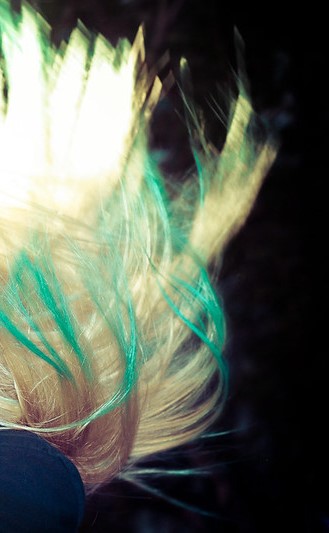Streaks involve coloring only a few strands of hair whereas highlights involve creating lighter shades on the entire head. Both these techniques can enhance your look and add dimension to your hair.
What are streaks?

Streaks are a hair coloring technique where small sections of the hair are colored with a lighter or darker shade than the rest of the hair. This creates bold and noticeable streaks that add dimension to your hairstyle. Streaks can be applied to any color of hair, but they work best on dark-colored strands.
One advantage of getting streaks is that it’s an easy way to switch up your look without making major changes. You can choose subtle or bold colors depending on how much you want to stand out. Additionally, it works well for people who want a low-maintenance hairstyle since you don’t have to get touch-ups as often as other techniques.
However, there are some downsides to consider before getting streaks. For example, if not done properly, streaking can result in uneven color distribution and damage your locks. It’s also essential to keep in mind that certain workplace dress codes may prohibit loud hairstyles like this one.
While there are pros and cons when it comes to getting highlights or streaks for your hair, if you’re looking for a way to add texture and depth without too much upkeep – then considering adding some fun patches could be just what you need!
What are highlights?
(Photo by Labskiii)

Highlights are a type of hair coloring technique where certain strands of hair are lightened to create contrast and dimension. This is typically done using bleach or a lighter color dye, which is applied to specific sections of the hair.
The purpose of highlights is to add depth and texture to the hair, creating a natural-looking effect that mimics how the sun would naturally lighten your locks. Depending on the desired result, highlights can be subtle or bold, with different shades being used for more dramatic effects.
One popular type of highlighting technique is called “foil highlights,” in which small sections of hair are wrapped in foil before being colored. This helps ensure that only those specific strands are lightened while keeping other parts of the hair untouched.
Another trend in recent years has been “ombre” or “balayage” highlights, which involve gradually lightening the bottom half or ends of the hair for a more gradual transition from dark roots to lighter tips.
Highlights offer an effective way to add some brightness and interest to your hairstyle without committing to full-blown color changes.
Streaks Vs. Highlights – Key differences
Streaks and highlights are both popular hair coloring techniques that can add dimension and depth to your hair. However, there are some key differences between them.
Streaks typically involve adding a bold, contrasting color to small sections of the hair. This technique creates a noticeable contrast between the natural color of your hair and the streaked sections. In contrast, highlights involve lightening small sections of the hair to create a more subtle, sun-kissed effect.
Another key difference is in the placement of these colors. Streaks usually follow a less structured pattern and can be placed anywhere throughout the hair for an edgier look. Meanwhile, highlights tend to be placed strategically on areas where sunlight would naturally hit for a realistic effect.
When it comes down to choosing which method to use, consider what kind of look you want to achieve – dramatic or subtle? Bold or natural? Keep in mind that both techniques require maintenance over time as they grow out with your natural roots.
Whether you choose streaks or highlights depends on personal preference and style goals.
How to choose the right type of streaks or highlights for your hair
Choosing the right type of streaks or highlights for your hair can be a challenging task. One way to make this decision is by considering your skin tone and natural hair color. If you have warm undertones, golden blondes and copper tones could be suitable options. On the other hand, if you have cool undertones, ash blonde or champagne colors may complement your complexion.
Another factor to consider when choosing between streaks and highlights is the overall look that you are aiming for. Streaks typically involve larger sections of dyed hair while highlights consist of thinner strands that are woven throughout the natural hair color. Streaks can create a bold statement while highlights provide a subtle brightness.
Additionally, it’s important to think about how often you want to maintain your new color. Highlights generally require less upkeep as they blend with the natural color as opposed to stark contrasts seen in streaking techniques.
Ultimately, consulting with a professional stylist who has experience working with different highlighting techniques can help guide you towards achieving optimal results based on your individual preferences and needs.
Do streaks damage your hair?
The answer is that it depends on the method used and how well you take care of your hair.
If the streaking process involves bleaching or coloring, then yes, there is a risk of damage to your strands. This is because these chemicals can strip away moisture from your hair and weaken its structure. If not done properly, this could lead to split ends, breakage, and even complete hair loss.
However, there are methods like foil highlighting that minimize the risk of damage by protecting the rest of your locks from bleach or dye. It’s also important to use high-quality products for maintenance such as deep conditioning treatments which help protect against dryness caused by chemical exposure.
The bottom line is that with proper care before, during and after any type of coloring process including highlights or streaks will keep our locks looking healthy without any issues in future!
How is hair streak done?
Hair streaks are a great way to add dimension and color to your hair. The process of getting hair streaks involves selecting strands of hair that will be colored differently than the rest. There are different techniques used for creating hair streaks, with some requiring more skill than others.
One popular method is the foil technique, which involves using aluminum foils to separate the sections of hair that will be colored. The stylist applies bleach or dye onto each section before wrapping it in foil and leaving it on for a period of time. This results in distinct lines of color throughout the hair.
Another method is called freehand painting, where stylists use brushes or combs to apply color directly onto sections of hair without any separation or foiling. This creates a more natural look compared to traditional streaking methods.
The final result ultimately depends on personal preference as well as the expertise of your stylist. Hair care after getting streaks should involve regular conditioning treatments and avoiding excessive heat styling which can damage your new highlights.
How is hair highlights done?
Hair highlights are a popular way to add dimension and depth to your hair color. There are various techniques used by hairstylists, but the most common one involves using foils or strategically painting on lighter shades of color onto selected strands of hair.
To begin with, the hairstylist will section off your hair into small sections and apply a lightening agent or bleach onto the desired portions. The amount of time for which it is left on depends on how light you want the highlights to be. Once they have reached their desired level of lightness, they are rinsed out thoroughly.
After this step, toner may also be applied to neutralize any unwanted brassy tones in the highlighted areas. After washing and conditioning your hair, your stylist will style it according to your preference.
It’s important to note that getting highlights requires an understanding of what kind of look you’re going for as well as taking into account factors like skin tone and natural hair color. Therefore it’s always best to consult with a professional before opting for this treatment!
What is the difference between highlights streaks and balayage?
When it comes to hair coloring techniques, highlights, streaks, and balayage are often used interchangeably. However, each technique has its unique characteristics that set it apart from the others.
Highlights involve lightening sections of your hair using foil or a cap. They create a more dramatic look by creating contrast between the dyed sections and your natural hair color. On the other hand, streaks entail dyeing thin sections of hair with a lighter shade than your natural color for a subtle but noticeable effect.
Balayage is similar to highlights in that it involves lightening certain sections of hair. The main difference lies in how the dye is applied. Balayage means “to sweep” in French and involves painting individual strands by hand rather than using foils or caps like highlights.
The result is softer and more blended compared to traditional highlighting methods. With balayage, you get sun-kissed locks that appear as if they have naturally been highlighted over time.
While highlights create bold contrasts between dyed and natural hair colors; streaks offer subtler accents on select portions of one’s mane; balayage provides seamless blending for an overall softened effect—no matter which technique you choose; there’s always an option to suit every preference!









